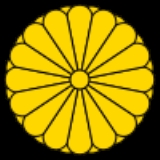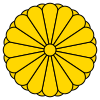
Shinnoke
Encyclopedia

Japan
Japan is an island nation in East Asia. Located in the Pacific Ocean, it lies to the east of the Sea of Japan, China, North Korea, South Korea and Russia, stretching from the Sea of Okhotsk in the north to the East China Sea and Taiwan in the south...
, which were until 1947 entitled to provide a successor to the Chrysanthemum throne
Chrysanthemum Throne
The is the English term used to identify the throne of the Emperor of Japan. The term can refer to very specific seating, such as the takamikura throne in the Shishin-den at Kyoto Imperial Palace....
if the main line failed to produce an heir. The heads of these royal houses held the title of , regardless of their genealogical distance from the reigning Emperor, as the term seshū in their designation meant that they were eligible for succession.
History
The Imperial family of Japan considers itself a single dynasty in unbroken succession; however, the succession has often not been directly from father to son, but has been in the male line within a closely related group of people. In the Muromachi periodMuromachi period
The is a division of Japanese history running from approximately 1336 to 1573. The period marks the governance of the Muromachi or Ashikaga shogunate, which was officially established in 1338 by the first Muromachi shogun, Ashikaga Takauji, two years after the brief Kemmu restoration of imperial...
, Prince Yoshihito, the son of the Northern
Northern Court (Japan)
The , also known as the "Ashikaga Pretenders" or "Northern Pretenders", were a set of six pretenders to the throne of Japan during the Nanboku-chō period from 1336 through 1392...
Emperor Sukō
Emperor Suko
) was the third of Ashikaga Pretenders during the Period of the Northern and Southern Courts in Japan. According to pre-Meiji scholars, his reign spanned the years from 1348 through 1351.-Genealogy:...
was permitted to establish a parallel lineage to the main imperial line, and took the name Fushimi-no-miya
Fushimi-no-miya
The ' is the oldest of the four shinnōke, branches of the Imperial Family of Japan which were eligible to succeed to the Chrysanthemum Throne in the event that the main line should die out....
from the location of his palace. This served politically to cement the reunification of the Northern and Southern Court, but provided insurance in the extreme event that the main imperial line should fail to produce a direct heir and become extinct.
This proved to be a fortunate decision, as in 1428, the son of the 2nd Prince Fushimi-no-miya ascended the throne as Emperor Go-Hanazono
Emperor Go-Hanazono
was the 102nd emperor of Japan, according to the traditional order of succession. His reign spanned the years from 1428 through] 1464....
.
In the Edo period
Edo period
The , or , is a division of Japanese history which was ruled by the shoguns of the Tokugawa family, running from 1603 to 1868. The political entity of this period was the Tokugawa shogunate....
, three additional seshū shinnōke households were created by the Tokugawa shogunate
Tokugawa shogunate
The Tokugawa shogunate, also known as the and the , was a feudal regime of Japan established by Tokugawa Ieyasu and ruled by the shoguns of the Tokugawa family. This period is known as the Edo period and gets its name from the capital city, Edo, which is now called Tokyo, after the name was...
, in conscious imitation of the
However, aside from Emperor Go-Hanazono
Emperor Go-Hanazono
was the 102nd emperor of Japan, according to the traditional order of succession. His reign spanned the years from 1428 through] 1464....
, the only time a member of the seshū shinnōke ascended to the throne was in 1779, when the son of Prince Kan'in-no-miya Sukehito became Emperor Kōkaku
Emperor Kokaku
was the 119th emperor of Japan, according to the traditional order of succession.Kōkaku's reign spanned the years from 1780 through 1817.-Genealogy:...
.
Within the seshū shinnōke households, younger non-heir sons (who were titled ), had two career options. They could "descend" to subject status with a surname such as Minamoto or Taira, and serve as a government official, or they could enter the Buddhist priesthood, generally as the head of one of the monzeki
Monzeki
Monzeki were Japanese Buddhist priests of aristocratic or imperial lineage. The term was also applied to the temples in which they lived....
temples in and around Kyoto
Kyoto
is a city in the central part of the island of Honshū, Japan. It has a population close to 1.5 million. Formerly the imperial capital of Japan, it is now the capital of Kyoto Prefecture, as well as a major part of the Osaka-Kobe-Kyoto metropolitan area.-History:...
. During the Edo period, the latter practice became almost universal. Non-heir sons who entered the priesthood were styled , and were automatically excluded from the succession, but could be recalled to "secular" status (and thus reinstated as potential successors) as need arose. Daughters were frequently used as pawns to cement matrimonial alliances with kuge
Kuge
The was a Japanese aristocratic class that dominated the Japanese imperial court in Kyoto until the rise of the Shogunate in the 12th century at which point it was eclipsed by the daimyo...
, daimyō
Daimyo
is a generic term referring to the powerful territorial lords in pre-modern Japan who ruled most of the country from their vast, hereditary land holdings...
or the Tokugawa
Tokugawa clan
The was a powerful daimyo family of Japan. They nominally descended from Emperor Seiwa and were a branch of the Minamoto clan by the Nitta clan. However, the early history of this clan remains a mystery.-History:...
houses. Unwed daughters often became Buddhist nuns.
During and after the Meiji Restoration
Meiji Restoration
The , also known as the Meiji Ishin, Revolution, Reform or Renewal, was a chain of events that restored imperial rule to Japan in 1868...
, members of the seshū shinnōke often served in the Imperial Japanese Army
Imperial Japanese Army
-Foundation:During the Meiji Restoration, the military forces loyal to the Emperor were samurai drawn primarily from the loyalist feudal domains of Satsuma and Chōshū...
or Imperial Japanese Navy
Imperial Japanese Navy
The Imperial Japanese Navy was the navy of the Empire of Japan from 1869 until 1947, when it was dissolved following Japan's constitutional renunciation of the use of force as a means of settling international disputes...
.
The four seshū shinnōke lineages
The four seshū shinnōke were, in order of creation:- Fushimi-no-miyaFushimi-no-miyaThe ' is the oldest of the four shinnōke, branches of the Imperial Family of Japan which were eligible to succeed to the Chrysanthemum Throne in the event that the main line should die out....
- Katsura-no-miyaKatsura-no-miyaThe ' was the one of the four shinnōke, branches of the Imperial Family of Japan which were eligible to succeed to the Chrysanthemum Throne in the event that the main line should die out. It was founded by Prince Toshihito, a grandson of Emperor Ōgimachi and brother of Emperor Go-Yōzei...
- Arisugawa-no-miyaArisugawa-no-miyaThe ' is one of the shinnōke, branches of the Imperial Family of Japan which were, until 1947, eligible to succeed to the Chrysanthemum Throne in the event that the main line should die out....
- Kan'in-no-miyaKan'in-no-miyaThe ' is the youngest of the four shinnōke, branches of the Imperial Family of Japan which were eligible to succeed to the Chrysanthemum Throne in the event that the main line should die out. It was founded by Prince Naohito, the son of Emperor Higashiyama....
.
The Katsura-no-miya and Arisugawa-no-miya houses died out in 1881 and 1913, respectively. The sixteenth son of Prince Kuniie
Prince Kan'in Kotohito
, wasthe sixth head of a cadet branch the Japanese imperial family, and a career army officer who served as Chief of the Imperial Japanese Army General Staff from 1931 to 1940.-Early years:...
, the twentieth head of the Fushimi-no-miya, succeeded to the Kan'in-no-miya house in 1875.
The Fushimi-no-miya house was the progenitor of nine other cadet branches of the imperial family, the ōke
Oke
The , were branches of the Japanese Imperial Family created from branches of the Fushimi-no-miya house. All but one of the ōke were formed by the descendants of Prince Fushimi Kuniye. The ōke were stripped of their membership in the Imperial Family by the American Occupation Authorities in...
, during the reign of Emperor Meiji.
The seshū shinnōke and ōke households, along with the kazoku
Kazoku
The was the hereditary peerage of the Empire of Japan that existed between 1869 and 1947.-Origins:Following the Meiji Restoration of 1868, the ancient court nobility of Kyoto regained some of its lost status...
(Japanese peerage
Peerage
The Peerage is a legal system of largely hereditary titles in the United Kingdom, which constitute the ranks of British nobility and is part of the British honours system...
), were reduced to commoner status during the American occupation
Occupied Japan
At the end of World War II, Japan was occupied by the Allied Powers, led by the United States with contributions also from Australia, India, New Zealand and the United Kingdom. This foreign presence marked the first time in its history that the island nation had been occupied by a foreign power...
of Japan, in October 1947.

